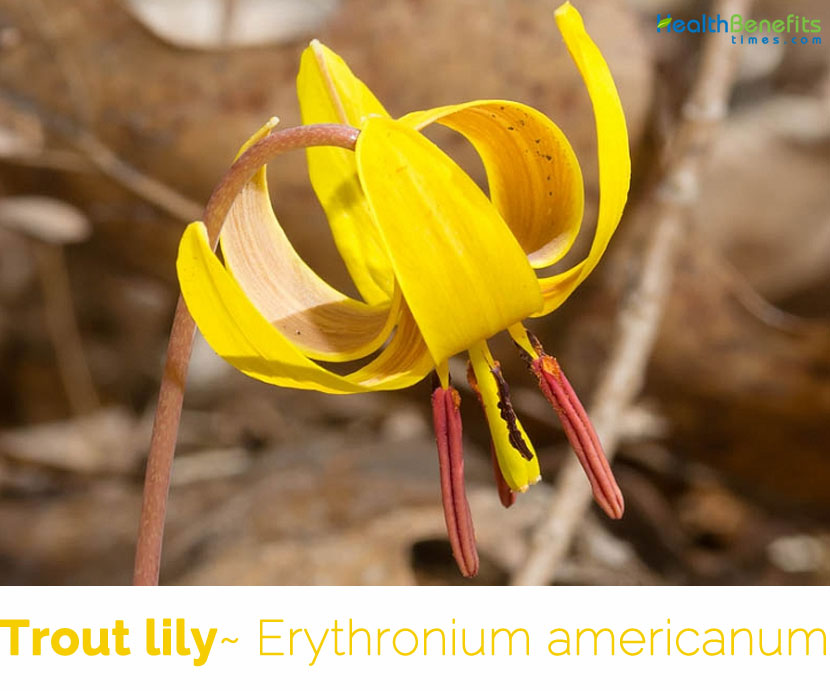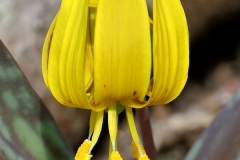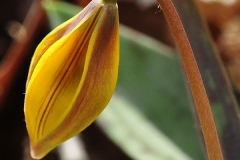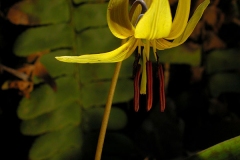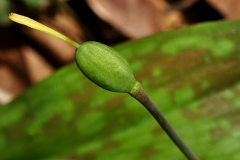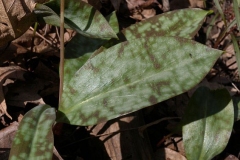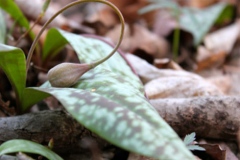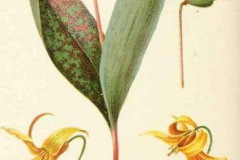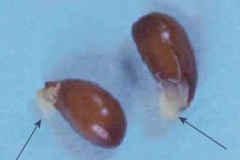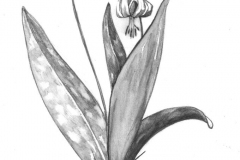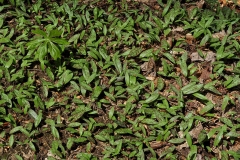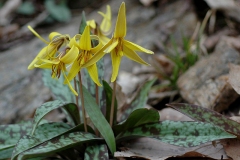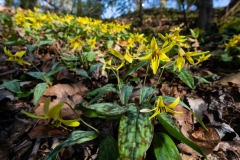| Trout Lily Quick Facts | |
|---|---|
| Name: | Trout Lily |
| Scientific Name: | Erythronium americanum |
| Origin | Eastern part of the US and Canada, from southern Ontario to Minnesota, south to South Carolina |
| Colors | Green, changing to brown |
| Shapes | Seed capsules about ½ to ¾ inch length rounded, 3-celled |
| Taste | Bitter, acrid |
| Health benefits | Beneficial for cystitis and nephritis, anxiety, insomnia, muscle tension, wounds, abscesses, mycobacteria infections, fever, fainting, ulcers, tumors and swollen glands |
| Name | Trout lily |
|---|---|
| Scientific Name | Erythronium americanum |
| Native | Eastern part of the US and Canada, from southern Ontario to Minnesota, south to South Carolina, Georgia, and Tennessee, west to Mississippi and Arkansas. This species is listed as Threatened in Iowa |
| Common Names | Trout Lily, Dogtooth violet, yellow adder’s tongue, Yellow Trout-lily, American Trout-lily, Eastern Trout-lily, Yellow Dogtooth Violet, Adder’s Tongue, Serpent’s Tongue, Yellow fawn-lily, Yellow Snowdrop, Amberbell, fish hooks, lamb’s tongue, serpent’s tongue, snake leaf, snake root, spring lily, yellow lily,Fawn Lily, yellow bells |
| Name in Other Languages | Danish: Gul hundetand, Amberbell, Dogtooth violet, Trout-lily, Yellow adder’s-tongue, Yellow trout lily, American trout lily, Yellow dog’s-tooth violet English: Dogtooth violet, Eastern trout-lily, Yellow dogtooth violet, yellow adder’s tongue French: Érythrone d’Amérique, Ail douce, Ail doux German: Ostamerikanischer Hundszahn Russian: Kandık amerikanskiy (Кандык американский) Swedish: Bronsfärgad hundtandslilja Upper Sorbian: Ameriski hrymzyčnik |
| Plant Growth Habit | Colony forming, spring short-lived small yellow wildflower |
| Growing Climates | Meadows, rich damp open woodland, along streams, slopes of ravines, Cliffs, balds, or ledges, forests, wooded bluffs, rocky woodlands, and banks of streams, deciduous woodlands |
| Soil | Prefers slightly acid soil conditions but succeeds in chalky soils if these contain plenty of humus. Succeeds in almost any light soil, preferring one that is rich in humus |
| Plant Size | Up to about 6 to 8 inches tall |
| Root | Root system consists of a corm, with fibrous roots and stolons that create offshoots from the mother plant, resulting in colonies of plants |
| Leaf | Elliptic or lance-shaped and mottled with brown, reddish-brown, or purplish-brown. The leaves are 2½ to 6 inches long and ½ to 2 inches across |
| Flowering season | March to April |
| Flower | Yellow flowers are solitary and nodding, appearing at the end of the single stem. The flowers are about an inch wide |
| Fruit Shape & Size | Seed capsules about ½ to ¾ inch length rounded, 3-celled capsule |
| Fruit Color | Green, changing to brown |
| Seed | Crescent-shaped seeds |
| Propagation | By Root Division , Seeds |
| Flavor/Aroma | |
| Taste | Bitter, acrid |
| Plant Parts Used | Leaves, root |
| Available Forms | Tincture or poultice |
| Season | May to June |
| Precautions |
|
Plant Description
Trout lily is a colony forming, spring, short-lived small yellow wildflower plant that normally grows up to about 6 to 8 inches tall. The plant is found growing in meadows, rich damp open woodland, along streams, slopes of ravines, Cliffs, balds, or ledges, forests, wooded bluffs, rocky woodlands, and banks of streams and deciduous woodlands. The plant prefers slightly acid soil conditions but succeeds in chalky soils if these consist of plenty of humus. Similarly it succeeds in almost any light soil. Root system consists of a deeply buried, bulb-like corm, light brown, about 1 inch long, and solid with white starchy flesh with fibrous roots and stolons that create offshoots from the mother plant, resulting in colonies of plants. Trout lily has no stem except for when it flowers then one flower appears per stem. This perennial herbaceous spring plant grows from a deep, ovoid bulb that can send up several single-leaved sterile offshoots along with the fertile plant. The bulb has a brown outer layer and an off white center. They are about 0.5 inches in diameter and lie roughly 2-5 inches below the surface. Nectar is produced at the base of the tepals, typical of plants in the family Liliaceae.
Leaves
Basal leaves are 2½-6 inches long and ½-2 inches across. They are ascending to erect, elliptic-lanceolate in shape, and smooth (entire) along their margins. Upper leaf surface is mottled pale green and brown or greenish brown, while the lower surface is solid medium green. Both surfaces are glabrous and the lower surface is often glaucous. The petioles of these leaves are relatively long, but they are located mostly or entirely underneath the ground surface. Immature shoots (Sterile) are single-leaved and they produce no flowers, while mature shoots have two leaves and they produce single-flower. Immature shoots are more common than mature shoots.
Flower
After seven years of growing, one slender, cylindrical scape grows between the leaves to produce a single flower. The scape is 4-8 inches long and curves at the end with the flower facing downward. The nodding flower is ¾-1¼ inches long, consisting of 6 yellow tepals, 6 stamens, and an ovary with 3 erect stigmata. They are sometimes tinged with purple or reddish brown on the outside of the petals. Initially, the tepals are barely separated from each other, but as the flower matures they become strongly recurved, exposing the reproductive organs. These tepals are narrowly elliptic-lanceolate in shape, and they are often tinted red or reddish brown along their outer sides. The stamens are about ½ inches long and their anthers are yellow or yellow-brown. The blooming period occurs during mid-spring and lasts about 2 weeks. The flowers are hermaphrodite (have both male and female organs).
Fruit
Later, the fertile flowers are replaced by obovoid seed capsules that are about ½ to ¾ inch in length or a little longer. These capsules are glabrous and their tops are truncate to round. The capsule starts out as green, changing to brown and splitting open into three sections to expose the crescent-shaped seeds. Ripening of the fruit starts from May to June.
Traditional uses and benefits of Trout lily
- All parts of the plant, but especially the bulb and the fresh leaves, are strongly emetic and are not used internally.
- Fresh leaves are also antiscrofulatic and emollient and are used as an infusion or stimulating poultice applied to swellings, tumors and scrofulous ulcers.
- The juice from crushed leaves has been applied to wounds that are not healing.
- Poultice of the crushed bulbs has been applied to swellings and to help remove splinters.
- Raw plant, excluding the roots, has been used by native North American young girls to prevent conception.
- The Cherokee used the juice from warmed leaves for wounds and an infusion of the root for fever.
- The Iroquois used a poultice of smashed roots for swellings.
- Trout lily leaves and bulbs were once eaten for medicinal purposes as a contraceptive.
- Leaves and bulb are crushed and used to dress wounds and reduce swellings, for scrofula and other skin problems.
- Herbal tea made from the root and leaf is said to reduce fever and fainting, tea also taken for ulcers, tumors and swollen glands.
- Trout Lily has antibacterial, anti-inflammatory, lymphatic, wound healing and nervine properties.
- It is used for urinary tract conditions such as cystitis and nephritis; inflammations of the mucus membranes of the body, edema, chronic skin conditions, and stress-related conditions such as anxiety, insomnia and muscle tension.
- Externally it is used for wounds, abscesses and myco-bacteria infections of the skin.
- Root has been used to alleviate swellings and fever.
Culinary Uses
- Bulb can be consumed raw or cooked.
- Leaves can be consumed raw or cooked.
- It can also be added to salads.
- Eating the leaves will greatly reduce the vigor of the bulb, so can only be suggested in times of crisis.
- Flowers, flower buds and flower stems can be consumed raw or cooked.
- Very young leaves or corms can be used as a cooked vegetable.
- The corms are edible as well and have a cucumber-like taste.
- You can add this plant to a salad or eat them as a trail snack.
- You can also make a tea with the flower, leaves or corm (or all).
- Collect enough corms then they can be roasted.
Other Facts
- Plants spread freely by means of underground stems and make a delightful ground cover in dappled shade.
- Some trout lily colonies are 200 to 300 years old.
- It is said that the Cherokee Indians would chew Trout Lily root and spit it in the water to make fish bite.
- Its bulbs are sterile up to around their 7-8th year and produce only one leaf and no flowers.
- When they mature they put out two leaves and one, beautiful yellow nodding flower.
- The corms (roots) can be boiled and served with butter.
- Its yellow flowers turn toward the sun on sunny days and nod toward the ground at nighttime and on overcast days.
References:
https://www.itis.gov/servlet/SingleRpt/SingleRpt?search_topic=TSN&search_value=196365#null
https://pfaf.org/user/plant.aspx?latinname=Erythronium+americanum
http://www.missouribotanicalgarden.org/PlantFinder/PlantFinderDetails.aspx?taxonid=282235
https://plants.usda.gov/core/profile?symbol=ERAM5
https://en.wikipedia.org/wiki/Erythronium_americanum
https://www.wildflower.org/plants/result.php?id_plant=eram5
http://www.theplantlist.org/tpl1.1/record/kew-305739
https://www.inhs.illinois.edu/data/plantdb/detail/3081


